The assignment itself was a photo-shoot in Cockermouth during this year’s Georgian Fair. As I was expecting it to be busy a tripod was not really an option, and as I explain in the submission, I rapidly settled on a 50-200 telephoto as my primary lens. If you want to read the whole submission it’s available here on Scribd.
First up I was really pleased with the feedback – I was obviously nervous as this is the first time I've had any of my photography critically assessed in a meaningful way – but happily I needn’t have been. Peter made one comment on my chosen technique (I chose to use auto ISO – limited to ISO800) to the effect that he would have limited it to ISO400. At the time I went to ISO800 as the light was so poor and I was hand-holding at fairly long focal lengths.
Subsequently I went through the tolerance to noise exercise and concluded that I would be comfortable with ISO 800 for general use, but for critical use I would stay with ISO200 or lower.
On to the individual photos:
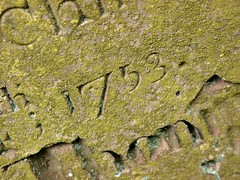
Peter acknowledged that this set the scene well and that my choice to frame diagonally added some interest to an otherwise static shot.
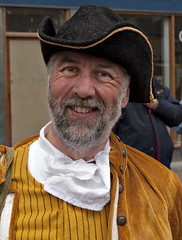
“This one is a pleasant enough portrait that I am sure your friend was very pleased with. You don’t say what the exposure was but a little fill in flash would help to add a touch of “sparkle”.”
Peter suggested fill flash at 2 stops under. I’m (still) kicking myself on this one as this was an early outing with my new E-3 which has a built in flash (unlike my previous E-1) so I could have done this – had I thought of it. It’s certainly a point to remember for People and Place – and for more general use.
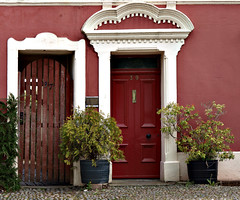
“The colours on this one are lovely. The maroon coloured house goes very nicely with the bushes at the front. The composition is excellent but too improve clone out the wire that is just above the right hand corner of the gate and leading to the upper floor. Also clone out the door bell just below “39” and the intercom (if that’s what it is) between the door and the side gate. Then there will be no trace of modernity on the image.”
Not an issue I’d thought of at the time of submission – although obviously the kind of improvement discussed has been a key issue in the fourth section of the course. I did all the cloning suggested with the exception of the ‘intercom’ – which on closer inspection turned out to be a brass name-plaque – which seemed reasonably in keeping with the setting.
On a broader point I think that these mods are acceptable for this and exhibition use, but I would be a little uncomfortable if I thought these cleaned up shots were going to be used to represent Cockermouth as it is now.
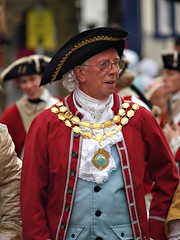
“I like this one very much. As you say in your notes a wide enough aperture has been used to throw the background out of focus thus concentrating the viewers eye on the main subject. Excellent.”
Nothing to add really other than to say that I was pleased that I managed to get the shot without a trace of modern clothing anywhere (other than the glasses).
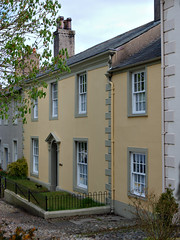
“Another good shot but again to capture the period you have chosen the clone tool should be used to improve.”
This time I lost a TV aerial and a genuine intercom, together with some phone cabling.
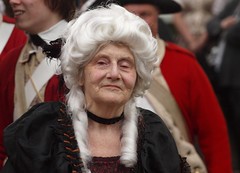
Again this is an excellent image with no trace of modernity whatsoever. The subject has been well caught and once more a relatively wide aperture has been used to make the subject stand out from the background. Another winner.
I guess you can begin to see why I was pleased – although on reflection I think this would have been improved by a wider aperture. I checked the original and it was shot at f8 – I think f4 would have provided better isolation from the background.
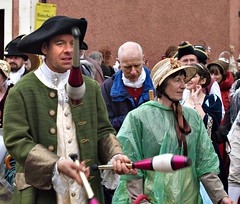
“Pictorially the club is cutting off a little of the jugglers face but I know this type of shot is not easy to execute. My advice would be to take several and select the best. Also a slightly slower shutter speed would emphasize more movement in the clubs.”
I find nothing to disagree with here. ‘Burst’ mode would certainly have given me more shots to choose from and since I included it in the collection to add some life I agree with the idea about the slower shutter-speed. I am a little uncomfortable about the impact of the green plastic mac on the overall setting as well – but it was raining, so macs or cagoules were to some degree inevitable.
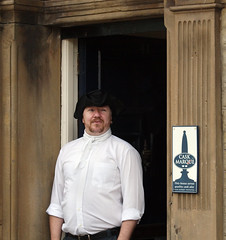
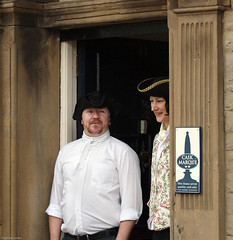
The right hand picture is the original submission which I include here to show the scale of the change and the end result.
“Another good candid shot but for me I would like to have seen more of the lady on the right hand side. I would be tempted to clone her out altogether so that the viewers eye is concentrated on the man making him the main subject of the image.”
I agreed, and completed this before I discovered that it was the technical requirement for Exercise 23. It is a much better shot with just one person. I was tempted to go the whole way and clone out the pub sign, but decided that it added some context.
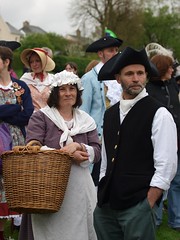
“Again you have another good candid shot but the background is a bit too distracting. A wider aperture would have given you a shallower depth of field thus concentrating the viewers eye on the couple in the foreground.”
Agree entirely. Shot at f8 when f4 would have been a better choice.
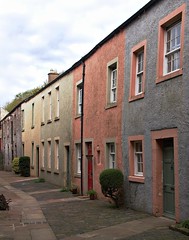
As noted in the other similar shots I have cloned out some intrusive cabling and modern wall furniture, as suggested.

“As far as I can see this image is faultless. You have included the whole of the instrument and the subjects hat has not been cropped off. Again you have used a wide aperture to render the background out of focus thus making the musician stand out. Brilliant.”
This one was taken at f4, unlike the couple above.
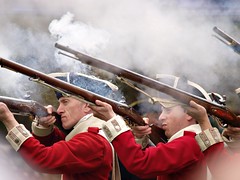
“Absolutely fantastic! The colours on this one are lovely and the atmospheric smoke from the guns hides any distractions in the background. Adding local contrast to the subjects faces has worked very well and the red uniform adds further impact and interest. Well done.”
A nice way to finish. I think I can see how I could have done it a little better, but my coach has told me I’m not good at accepting praise so I’m going to shut up at this point.
Conclusions
A number of practical conclusions leap out:
- be braver with shallow depth of field,
- work on the use of fill-in flash,
- think about shutter speeds more carefully when trying to capture ‘life’,
- pay more attention to the fine detail when preparing the pictures for submission.
Finally, on a personal note, I didn’t tell Peter at the time but his feedback was just the confidence boost I needed relatively early in the course.



No comments:
Post a Comment